8 August 1778 Saturday
"I believe only him. I have no confidence in anyone but him."
Artifacts of the Bianconi vs Piranesi 'Circus of Caracalla' affair 1772-1789
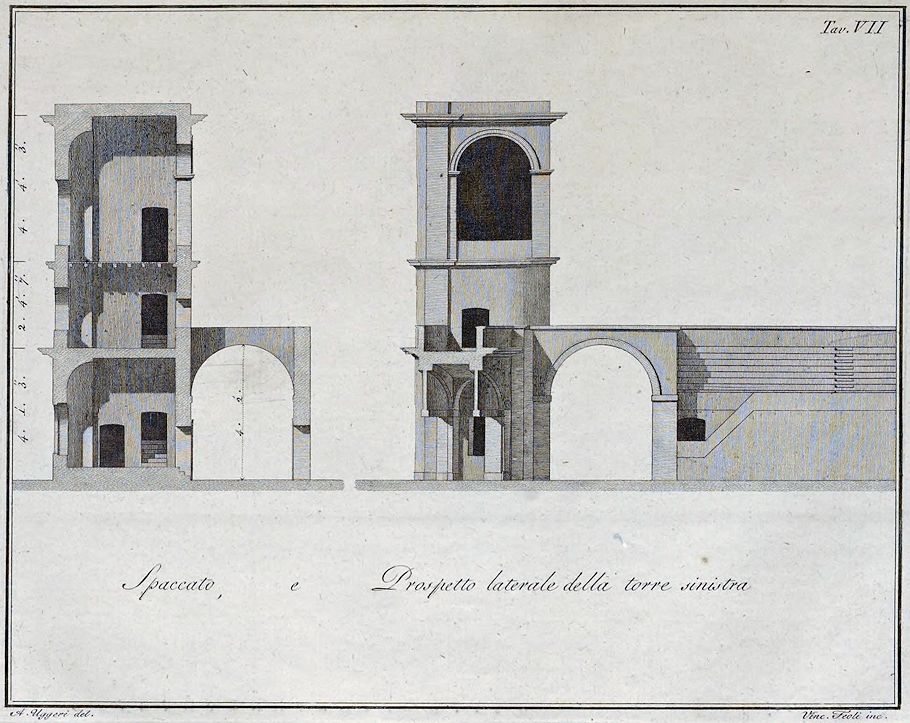
Tavola VII Section and side elevation of the left tower.
47 y.o. Francesco Piranesi 1805
Le Antichità della Magna Grecia Parte II
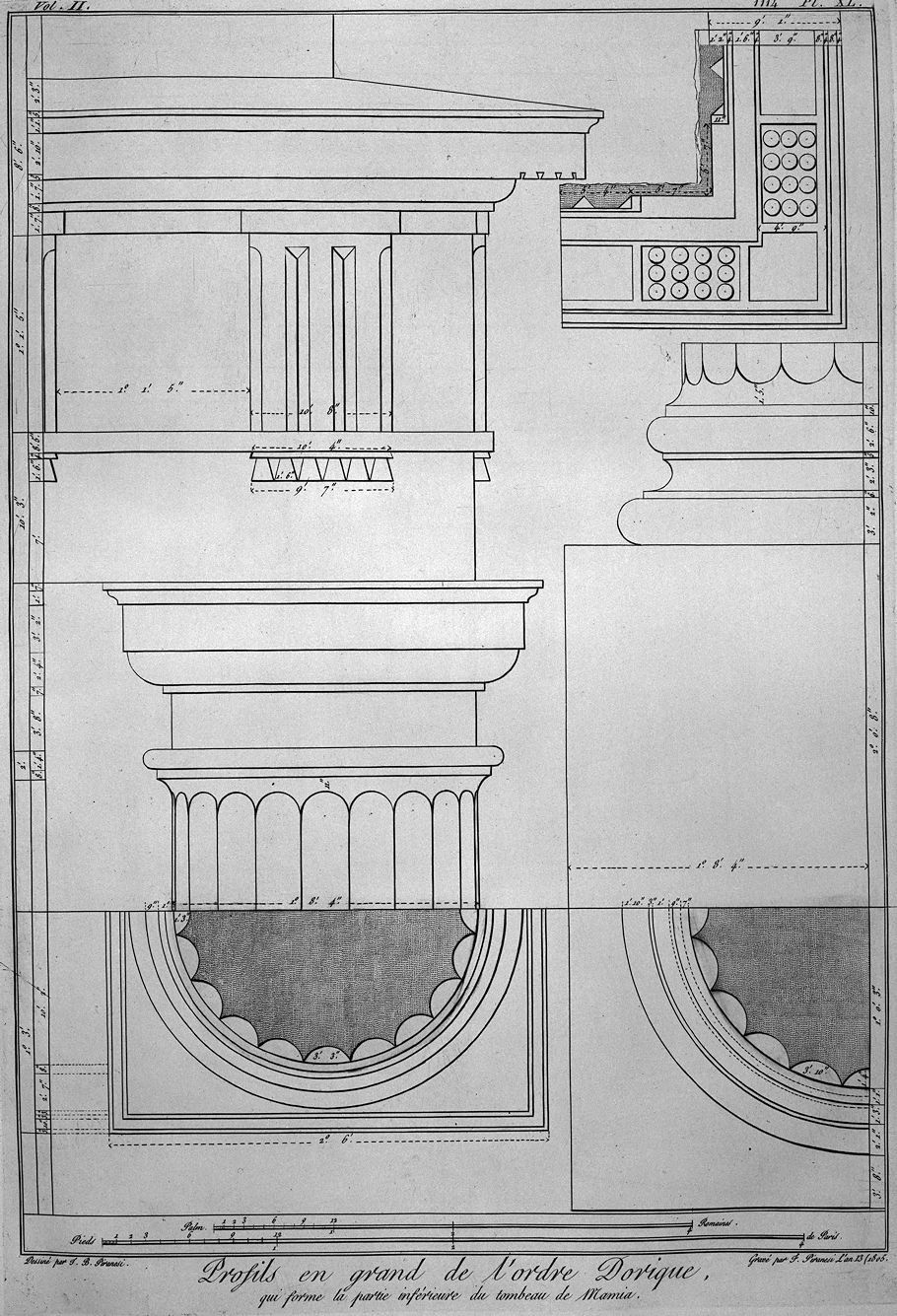
Large profiles of the Doric order, which forms the lower part of Mamia's tomb.
Drawn by G.B. Piranesi
Engraved by F. Piranesi Year 13 (1805)
8 August 1812 Saturday
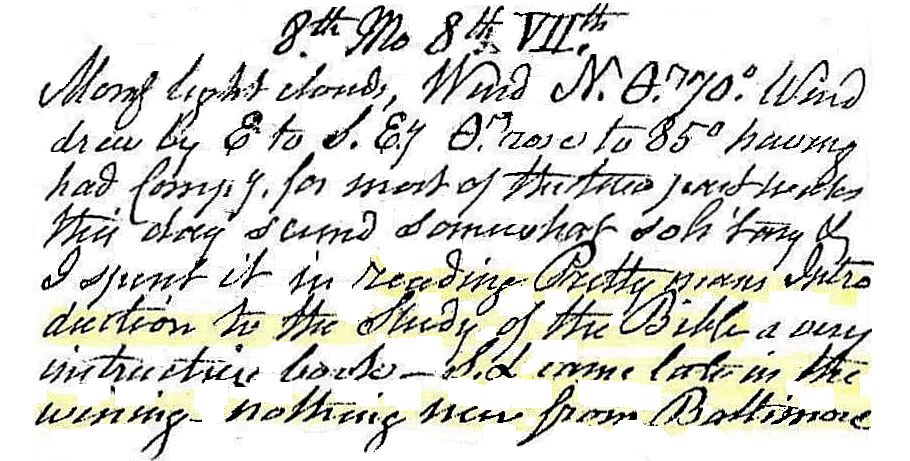
Morning light clouds, wind N, temperature 70°. Wind drew by E to SEerly, temperature rose to 85°. Having had company for most of the two past weeks, this day seemed somewhat solitary and I spent it in reading Prettyman's Introduction to the Study of the Bible, a very instructive book.
SL came late in the evening; nothing new from Baltimore.
8 August 1997
Redrawing the Campo Marzio
After rereading some of Tafuri's text on the Campo Marzio, for some reason it occurred to me that my redrawing of the Campo Marzio is an attempt to "walk in Piranesi's footsteps," meaning, I am trying to learn how Piranesi's imagination operated by doing the same thing he did--literally (re)drawing the plan. I am trying to get as close to Piranesi's own drawing/designing procedure as possible.
I then thought of what Collingwood said about not being able to truly learn from history because we are not able to actually experience history. In this sense, I am trying to re-experience a specific historic occurrence, albeit over 200 years later and with a different drawing technology. Besides the use of CAD, which is actually related to engraving in that it is a type of "drawing" that is readily reproducible, the major difference between what Piranesi did and what I am doing is that Piranesi was designing the plan(s) as he was drawing them, he was producing with his imagination and with his graphic dexterity. Whereas I am only measuring his work and then digitally inputting the data. I am learning through osmosis, however.
"Redrawing History: G. B. Piranesi's Campo Marzio in the Present"
...the opportunity to delve into the virtual realm and how reality and the virtual very much cross paths in the Campo Marzio.
8 August 1998
Saint Peter's Basilica
The Basilican Church of Saint Peter was erected by the emperor Constantine c.330 over the tomb of Saint Peter, which was also near Saint Peter's site of martyrdom in the Circus of Caligula and Nero. It is one of the largest imperial buildings constructed in Rome during the late years of the Empire. As such, its plan should be represented within the Ichnographia Campus Martius, however, it is not. Instead Piranesi fills the Vatican Valley with the elaborate Garden of Nero whose placement here is archeologically correct, although Piranesi's plan of the garden is entirely his own. Hence, it is easy to surmise that Piranesi simply chose to "reconstruct" this portion of ancient Rome according to its first century condition, and such a theory is plausible except that Piranesi also chose to include the Tomb of Honorius within the Garden of Nero, a sizable structure that was actually attached to Saint Peter's Basilica. The omission of Christianity's foremost shrine from the large plan therefore heralds ambiguity.
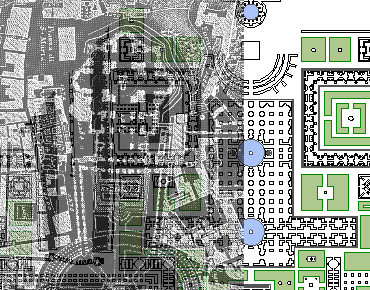
Finding the location within the Ichnographia of where the Basilica of Saint Peter's should be, begins to disclose Piranesi's intent. For example, in actuality the altar of St. Peter's Basilica sits directly above Saint Peter's tomb, which is part of row of tombs, and a superimposition of the basilica's plan and the Ichnographia plainly indicates that Piranesi places a row sepulchers precisely where they ought to be. Furthermore, the basilican plan of the Porticus Neronianae is certainly a reference to the Basilica of Saint Peter's, albeit inverted. It is as if Piranesi located St. Peter's Basilica within the Ichnographia without actually delineating it. This illusory mode of operation, moreover, infuses double meaning into the buildings of the Horti Neroniani that Piranesi does draw. It therefore becomes evident that Piranesi's rendition of the Porticus Neronianae is an imaginative reminder that not only did Saint Peter suffer and die under Nero's persecution of the Christians, but that in the end it is Saint Peter, through Christ, that ultimately triumphs. There is thus no doubt that Piranesi clearly recognized the tremendous irony whereby the most hedonistic of imperial Roman gardens ultimately became Christianity's terrestrial and spiritual center.
8 August 2001
damnatio memoriae and palimpsest
In doing further (re)reading of material on Helena and other Neo-Flavians, in Drijvers Helena Augusta (1992) on p. 49 there is a 'reprint' of inscription CIL X 678. This is the same evidence of damnatio memoriae where we have examples of both the dm of Crispus and Fausta. While there are more extant examples of the dm of Crispus, this is the only extant example of Fausts' dm. As I mentioned the other day, I went to look at all the Crispus and Fausta dms within the CIL at Temple U's library. Since those books are enormous, I only photocopied CIL X 678. There a fair amount of Latin commentary that goes with the inscription, and some of the commentary is (as I found out last night) translated in Drijvers book.
Not only were the words FAUSTA and UXORI (wife) erased, but they were replaced with HELENAE and MATRI. Thus, not only do we have here an example of damnatio memoriae, but an example of palimpsest as well. Question: is it a fairly common occurrence within other examples of dm for there to be a palimpsest as well, or is this more part of 'rare' damnatio memoriae subset?
Since CIL X 678 is the only extant example of Fausta's dm, I wonder if it might also be of some significance that it is actually a dm plus palimpsest. For example, could it be that Fausta's 'erasure' from memory is integral with Helena's 'inscription' into memory. Of course, on the immediate level, this tight connection appears obvious, but I'm still looking for other aspects and explanations that may enhance the understanding here. To sharpen the focus, I'm aware that there are many examples of palimpsests within inscriptions, so I'm more interested in examples where specific names/persons manifest a damnatio memoriae plus palimpsest combination.
ps
I also read last night in Pohlsander's Helena: Empress And Saint (1995) on p. 151: "The feast of the Invention of the Cross was previously observed in the West on 3 May but was suppressed by Pope John XXIII in 1960." Could this be considered one of the new forms of damnatio memoriae, or is it an example of purging history of what didn't happen? Is there a name for the act of purging history of what didn't happen?
8 August 2005
"How Did This Happen Revisited"
Last Friday I read about Vitruvius Britannicus in Architectural Theory: from the Renaissance to the Present (Taschen, 2003) and was surprised to learn:
"For Campbell St. Peter's is by no means merely an especially striking expression of architectural abuses on the Continent: it also stands for Italy's cultural decline. As such he emphasizes in his foreword that in the post-Palladian era Italy had not only become estranged from the true "taste of building," but also from the roots of its culture, the Latin language. From this perspective, Italy could no longer be the destination of the Grand Tour. Campbell considers such understandings to be "Mistakes in Education." As the Vitruvius Britannicus is intended to demonstrate, it is now the architects and artists of England who are to take Italy's place as the preservers of timeless, classical taste."
I cannot recall having ever read that Piranesi's [mid-life] oeuvre is in some ways a reaction to Vitruvius Britannicus, but I certainly see [that it could be] that way now.
8 August 2008
The arrogance of 'Architects'
In the Ichnographia Campus Martius "certain landmarks remained: the Tiber River, the Piazza Navona, and a Colosseum-like structure, which was in the wrong location and, in a sense, at the wrong
scale."
--Peter Eisenman, "Piranesi and the City" (2007).
In fact, the 'Colosseum-like structure' is clearly labeled Amphitheatum Statilii Tauri, positioned by Piranesi in its most likely location, and delineated at about 2/3rds the size of 'the Colosseum' which is probably what the Amphitheater of Statilius Taurus was.
Eisenman's misrepresentation of the facts here is somewhat compounded in that Wilton-Ely had already years earlier noted the presence of the Amphitheater of Statilius Taurus within Piranesi's Campo Marzio.
Eisenman interprets Piranesi's Ichnographia Campus Martius in several self-serving ways, but he never comes to realize that on one level the Ichnographia Campus Martius is a gigantic test of Ancient Roman topography.

"Hey Doctor. I don't know what you want me to see, but this thing I'm looking through looks like some plan from Piranesi's Campo Marzio."
Adam (sans Eve) in the Garden of Satire
August 8, 1977
Fully packed for Rome. Luggage weighs 33 lbs. I weigh 172 lbs. Leaving for New York with $107.00.
8 August 2020
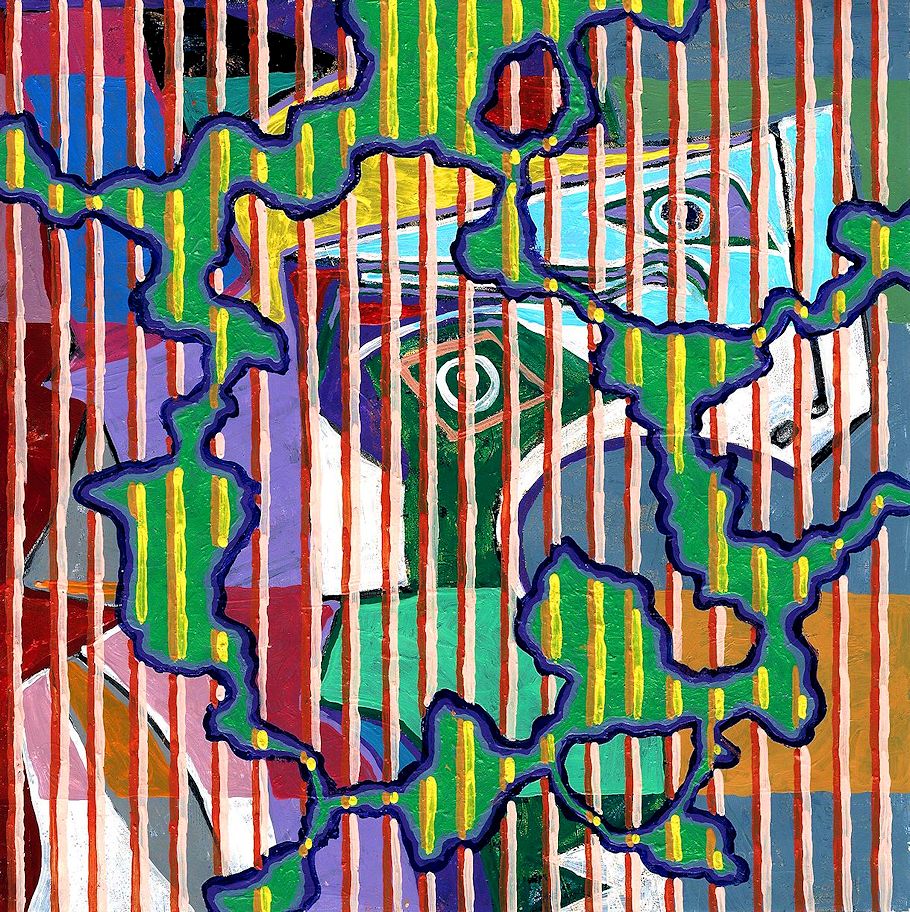
Mary Boone's 180 hours of community service hours 152 153 154 155 156
8 August 2022
... Instead, I collected textual passages pertaining to Piranesi's longtime bladder ailment which may well have precipitated his ultimate demise:
He [Piranesi] returned to Rome a dying man, but he insisted on continuing with his etching. When a doctor was suggested, he called for his volumes of Livy: "I have no confidence in anyone but him." Towards the end, despite acute pain, he refused to stay in bed. "Rest is unworthy of a citizen of Rome; let me see my models again, my drawings, my plans," He died on 9th November 1778 and was buried not, as he had intended, in the church of S. Maria degli Angeli in the Baths of Diocletian, but in his parish church of S. Andrea delle Fratte. A couple of years later, at the request of Cardinal Rezzonico, his remains were moved to his own church on the Aventine.
Jonathan Scott, Piranesi (1975), pp. 253-4.
...
Am I correct in surmising that the text of Calcographia des Piranesi (Getty Research Institute) was heretofore overlooked by and/or unknown to the present-day realm of Piranesi scholars? I've found no bibliographic or footnote references within Piranesi literature of the past half century or so.
...
late night thoughts:
If, as seems very likely, Piranesi's health became progressively worse in 1778 through the rest of August and all of September and October, then, as seems equally likely, the redesigned Circus Maximus plan may be Piranesi's very last completed etching.
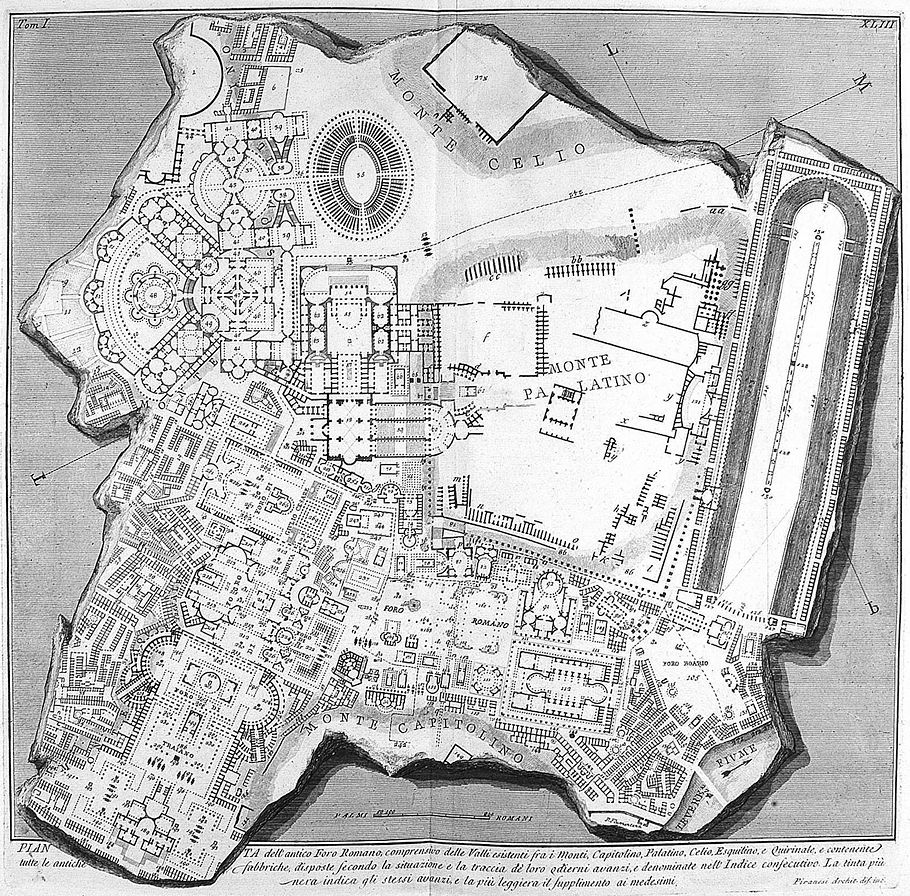
In bed, before falling asleep, it occurs to me that I was in Rome, and throughout other parts of Italy, for most of August 1977, and, at that time, I was the same age as Francesco Piranesi in August 1778. [Francesco was 20 years old in 1778, and I was 21 years old in 1977.]
8 August 2023 Tuesday
. . . . . .
|